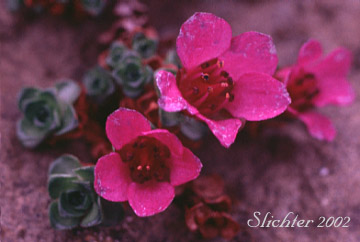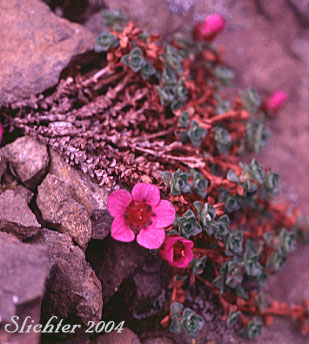

 The
photo at right shows the long stems, both fertile and sterile of purple mountain
saxifrage.
The
photo at right shows the long stems, both fertile and sterile of purple mountain
saxifrage.
Also known as purple saxifrage, purple mountain saxifrage is a very attractive perennial wildflower that forms thick, tufted cushions up to 20 cm high and 2-4 cm high. Plants are entirely glabrous except for the ciliated margins of the leaves and calyx lobes. The leaves are arranged along the sterile stems in pairs, with each pair at right angles to the pair above or below. Individual leaves are oblong to obovate in shape, sessile at the base and from 2.5-5 mm long. The leaves are glabrous on both surfaces and lined with coarse hairs along the margins. The leaves of the sterile shoots are closely overlapping. Those of the flowering stems are fewer in number, more loosely arranged, and sometimes alternate.
A single flower is found atop each fertile shoot. Each flower is either short-petioled or sessile. The cup-shaped calyx is 5-lobed, the erect lobes oblong-oval in shape, 2.5-3.5 mm long, and about 3/4 the length of the calyx. The margins of each calyx lobe are lined with coarse hairs. The erect petals are purple in color, 7-9 mm long, spatulate-obovate to ovate-oblong in shape, tapering to a short, wide claw. The stamens are about twice as long as the calyx lobes. The carpels are free of the calyx, 5-6 mm long, nearly erect and unite over half their length.
In the Pacific Northwest, purple mountain saxifrage may be found scree and rock crevices in alpine habitats, and on the tundra and on coastal bluffs in the northern portion of its range.
Purple mountain saxifrage may be found from Alaska south to the Olympic and central Washington Cascades of Washington and in the Wallowa Mts. of northeastern Oregon. It may be found eastward across northern Canada to Labrador and Newfoundland and south to Vermont. It is found southward through the Rocky Mts. to Montana, central Idaho and northern Wyoming.